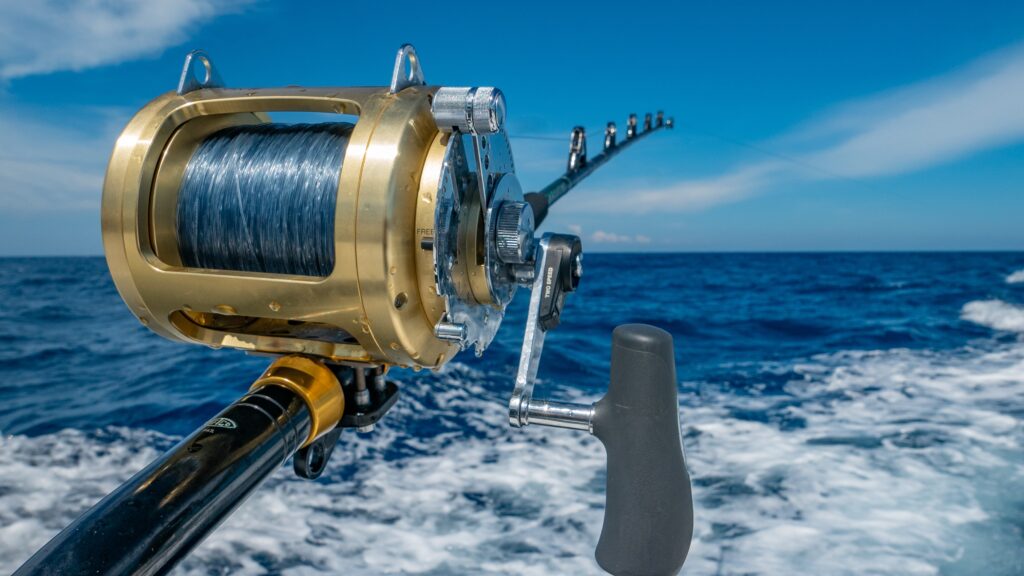If you’re a fishing enthusiast looking to optimize your spod rod experience, then look no further. This article provides essential advice on determining the ideal amount of fishing line for your spod rod, along with expert tips on line capacity and loading techniques. Whether you’re a beginner or a seasoned angler, mastering these key fundamentals will undoubtedly enhance your fishing prowess and increase your chances of a successful catch. So, grab your tackle box and get ready to revolutionize your spod rod fishing technique.

How Much Fishing Line for Spod Rod: Line Capacity and Loading Tips
If you’re into spod fishing, you know how crucial it is to have the right fishing line for your spod rod. The fishing line not only determines the line capacity of your reel but also affects casting distance, accuracy, and the overall performance of your spod rod. In this comprehensive guide, we will explore the factors you need to consider when selecting fishing line for your spod rod, how to determine the appropriate line capacity, and offer tips on loading and maintaining your fishing line.
Understanding the Spod Rod
What is a Spod Rod?
Before we delve into the specifics of fishing line selection, let’s briefly discuss what a spod rod is. A spod rod is a specialized fishing rod designed for a technique called spodding, which involves baiting an area by casting out a large, bait-filled spod. The spod rod allows you to cast heavier loads, typically ranging from 4 to 8 ounces, further distances with accuracy.
Importance of Choosing the Right Line Capacity
Choosing the right line capacity for your spod rod is essential for several reasons. Firstly, it ensures that you can handle the heavier loads associated with spodding without putting excessive strain on your reel or rod. Secondly, it affects casting distance and accuracy, allowing you to reach your desired fishing spot more effectively. Lastly, having the appropriate line capacity ensures that you can handle any potential battles with large fish that may be attracted to your baited area.
Factors to Consider When Selecting Fishing Line for Spod Rod
When selecting fishing line for your spod rod, there are several factors you need to consider. These factors include the type of fishing line, its breaking strength, diameter, and specific characteristics such as stretch and sensitivity. Additionally, you’ll need to ensure that the line capacity of your reel matches the requirements of your spod rod and the weight of the bait-filled spods you plan to cast.

Determining Line Capacity
Considering the Spod Rod’s Specifications
To determine the appropriate line capacity for your spod rod, you’ll need to refer to the rod’s specifications. Manufacturers typically provide information on the recommended line capacity range for each rod, allowing you to narrow down your options. It’s important to adhere to these guidelines to ensure optimal performance and prevent any damage to your spod rod.
Matching Line Capacity with Spod Weight
Another crucial aspect of determining line capacity is considering the weight of the spods you plan to cast. As a general rule, your fishing line should have a breaking strength that exceeds the weight of your spods by at least 25%. This gives you a margin of safety and ensures that your fishing line has enough strength to handle the strain of casting and retrieving the loaded spods without breaking.
Different Fishing Line Options
Now that we understand the importance of line capacity, let’s explore the three main types of fishing lines commonly used for spod fishing: monofilament, braided, and fluorocarbon.
Monofilament Line
Monofilament line is a popular choice for spod fishing due to its versatility, affordability, and ease of handling. It has a relatively high level of stretch, which can be advantageous when dealing with powerful fish that make sudden runs. Monofilament line also floats, which can be beneficial when fishing in shallow or weedy areas. However, it is prone to UV damage, has lower abrasion resistance compared to other lines, and can absorb water over time, compromising its strength.
Braided Line
Braided line is known for its exceptional strength-to-diameter ratio, offering the angler increased line capacity and casting distance. It has minimal stretch, providing excellent sensitivity and the ability to detect even the most subtle bites. Braided line also boasts high abrasion resistance and durability, making it suitable for fishing in snaggy or rocky environments. However, it tends to be more visible in the water, requires additional techniques for tying knots, and can be less forgiving when dealing with hard-fighting fish.
Fluorocarbon Line
Fluorocarbon line is renowned for its near-invisibility underwater, making it an excellent option for spod fishing in clear or highly pressured waters. It has a higher density than water, allowing it to sink rapidly, making it suitable for fishing at various depths. Fluorocarbon line also offers good abrasion resistance, but it can be stiffer and more challenging to manage, especially in colder temperatures. Additionally, fluorocarbon line tends to be more expensive than other options.

Pros and Cons of Monofilament Line
Advantages of Monofilament Line for Spod Fishing
-
Versatility: Monofilament line is suitable for various fishing conditions and techniques, making it a versatile option.
-
Affordability: Compared to braided or fluorocarbon lines, monofilament line tends to be more budget-friendly.
-
Stretch: The moderate stretch of monofilament line can act as a shock absorber, reducing the risk of line breakages when battling powerful fish.
Disadvantages of Monofilament Line for Spod Fishing
-
UV Damage: Monofilament line is prone to UV damage, so regular inspection and replacement is necessary to maintain its strength.
-
Water Absorption: Over time, monofilament line can absorb water, which can lead to reduced strength and performance.
-
Lower Abrasion Resistance: When compared to braided or fluorocarbon lines, monofilament line has lower abrasion resistance, making it less suitable for fishing in rough or snaggy areas.
Pros and Cons of Braided Line
Advantages of Braided Line for Spod Fishing
-
Strength-to-Diameter Ratio: Braided line offers exceptional strength for its diameter, allowing you to spool more line onto your reel and cast further distances.
-
Sensitivity: The minimal stretch of braided line provides excellent sensitivity, making it easier to detect subtle bites.
-
Abrasion Resistance: Braided line excels in environments with rocks or heavy vegetation, as it has high abrasion resistance.
Disadvantages of Braided Line for Spod Fishing
-
Visibility: Braided line can be more visible in the water, potentially spooking wary fish.
-
Knot-Tying Techniques: Tying knots with braided line may require additional techniques due to its smooth texture, ensuring secure connections.
-
Unforgiving Nature: When fighting hard-fighting fish, braided line may lack the forgiving stretch of monofilament line, increasing the risk of line breakages.

Pros and Cons of Fluorocarbon Line
Advantages of Fluorocarbon Line for Spod Fishing
-
Invisibility: Fluorocarbon line is nearly invisible underwater, making it ideal for clear or highly-pressured fishing situations.
-
Sink Rate: Fluorocarbon line has a higher density than water, allowing it to sink rapidly, enabling anglers to fish at various depths.
-
Durability: Fluorocarbon line has good abrasion resistance, making it suitable for fishing in areas with rocks or other potential hazards.
Disadvantages of Fluorocarbon Line for Spod Fishing
-
Manageability: Fluorocarbon line tends to be stiffer and more challenging to manage, especially in colder temperatures.
-
Price: Compared to monofilament or braided lines, fluorocarbon line tends to be more expensive.
Factors to Consider When Loading Line onto the Spod Rod
Now that we’ve covered the different fishing line options, let’s explore the key factors to consider when loading line onto your spod rod.
Correct Spooling Technique
To ensure optimal line performance, it’s essential to spool the line correctly onto your reel. Avoid any twisting or overlapping of the line when spooling, as this can lead to tangles or line breakages during casting. Use the manufacturer’s guidelines on how to spool the line properly to ensure smooth, trouble-free operation.
Maintaining Line Tension
Maintaining proper line tension while spooling is vital to prevent any loose or slack areas that can cause line tangling or casting issues. Apply gentle pressure with your hand while spooling to ensure an even and tight line lay on the reel.
Avoiding Line Twists
Line twists are a common issue when loading line onto your spod rod. To prevent them, ensure that the line is coming off the spool in the same direction as the line is going onto the reel. Additionally, periodically check for any twists by allowing the line to unwind freely and observing any loop formations or tangling.

Tips for Spod Fishing
To enhance your spod fishing experience, here are some additional tips that can help improve your overall performance:
Choosing the Right Line Diameter
Consider the line diameter when selecting fishing line for your spod rod. Thicker lines generally offer more strength and abrasion resistance, suitable for fishing in snaggy areas, whereas thinner lines provide increased casting distance and sensitivity.
Understanding Line Stretch and Sensitivity
Different fishing lines have varying degrees of stretch and sensitivity. Consider the specific characteristics you prefer when selecting your line. For instance, if you prefer a line with minimal stretch and high sensitivity, braided line would be an excellent choice.
Regularly Checking Line Condition
Regularly inspecting your fishing line for any signs of wear, damage or UV damage is crucial to maintain line performance and prevent any unexpected breakages. If you notice any weak spots, nicks, or fraying, it’s essential to replace the line immediately to avoid any potential mishaps while spod fishing.
Maintaining Line Quality
To ensure the longevity and performance of your fishing line, follow these maintenance tips:
Importance of Regular Line Inspection
Regularly inspecting your fishing line, especially after each fishing trip, allows you to identify any weaknesses, abrasions, or signs of damage that may compromise its strength and performance. By addressing any issues promptly, you can avoid any unpleasant surprises while spod fishing.
Replacing Worn-out or Damaged Line
When your fishing line shows signs of wear, damage, or reduced strength, it’s crucial to replace it promptly. Weakened line can lead to line breakages or failures during critical moments, potentially costing you the fish of a lifetime. Always have spare fishing line available, and make sure to replace worn-out or damaged line before your next spod fishing expedition.
Proper Storage and Handling of Fishing Line
Proper storage and handling practices can significantly enhance the lifespan of your fishing line. Store your fishing line in a cool, dry place away from direct sunlight or extreme temperatures, as these conditions can accelerate aging and degrade line performance. Avoid excessive bending or kinking of the line, as this can weaken or cause permanent damage. Additionally, ensure that your spod rod and reel are properly cleaned and maintained to prevent any residual dirt or debris from negatively affecting your fishing line.
In conclusion, selecting the right fishing line for your spod rod is essential for optimal performance, casting distance, and overall enjoyment of spod fishing. Consider the line capacity requirements of your spod rod, the weight of the bait-filled spods you use, and the specific characteristics of different fishing lines to make an informed choice. With proper line loading techniques and maintenance, you’ll be well-equipped for successful spod fishing adventures. Happy fishing!





